Southern Cross University: LAW72005 Evidence Case Study Review
VerifiedAdded on 2023/01/19
|11
|3172
|42
Case Study
AI Summary
This case study analyzes a Law of Evidence scenario involving a criminal trial where the admissibility of evidence is challenged. The central issue revolves around whether the conviction of two individuals, R and M, was based on wrongly admitted evidence, particularly the testimony of police officers reading statements from a missing witness, L. The analysis delves into the rules of evidence, focusing on relevancy, hearsay, and exceptions like res gestae. The case examines the admissibility of L's statements, considering whether they constitute hearsay and whether exceptions apply. The analysis also considers the relevance of circumstantial evidence, such as the suspects' criminal history and the discovery of beer cans. The conclusion suggests that the assault charges against R and M may not be proven beyond a reasonable doubt due to lack of direct evidence. The document cites several legal precedents to support its arguments and concludes that the prosecution must prove that the evidence is relevant and not hearsay to prove the case beyond a reasonable doubt.

Law of Evidence CASE STUDIES
Law of Evidence
Case studies
Law of Evidence
Case studies
Paraphrase This Document
Need a fresh take? Get an instant paraphrase of this document with our AI Paraphraser

Law of Evidence CASE STUDIES
Table of Contents
Issue.................................................................................................................................................2
Rule..................................................................................................................................................2
Application and Analysis.................................................................................................................2
Conclusion.......................................................................................................................................7
BIBLIOGRAPHY........................................................................................................................9
Table of Contents
Issue.................................................................................................................................................2
Rule..................................................................................................................................................2
Application and Analysis.................................................................................................................2
Conclusion.......................................................................................................................................7
BIBLIOGRAPHY........................................................................................................................9
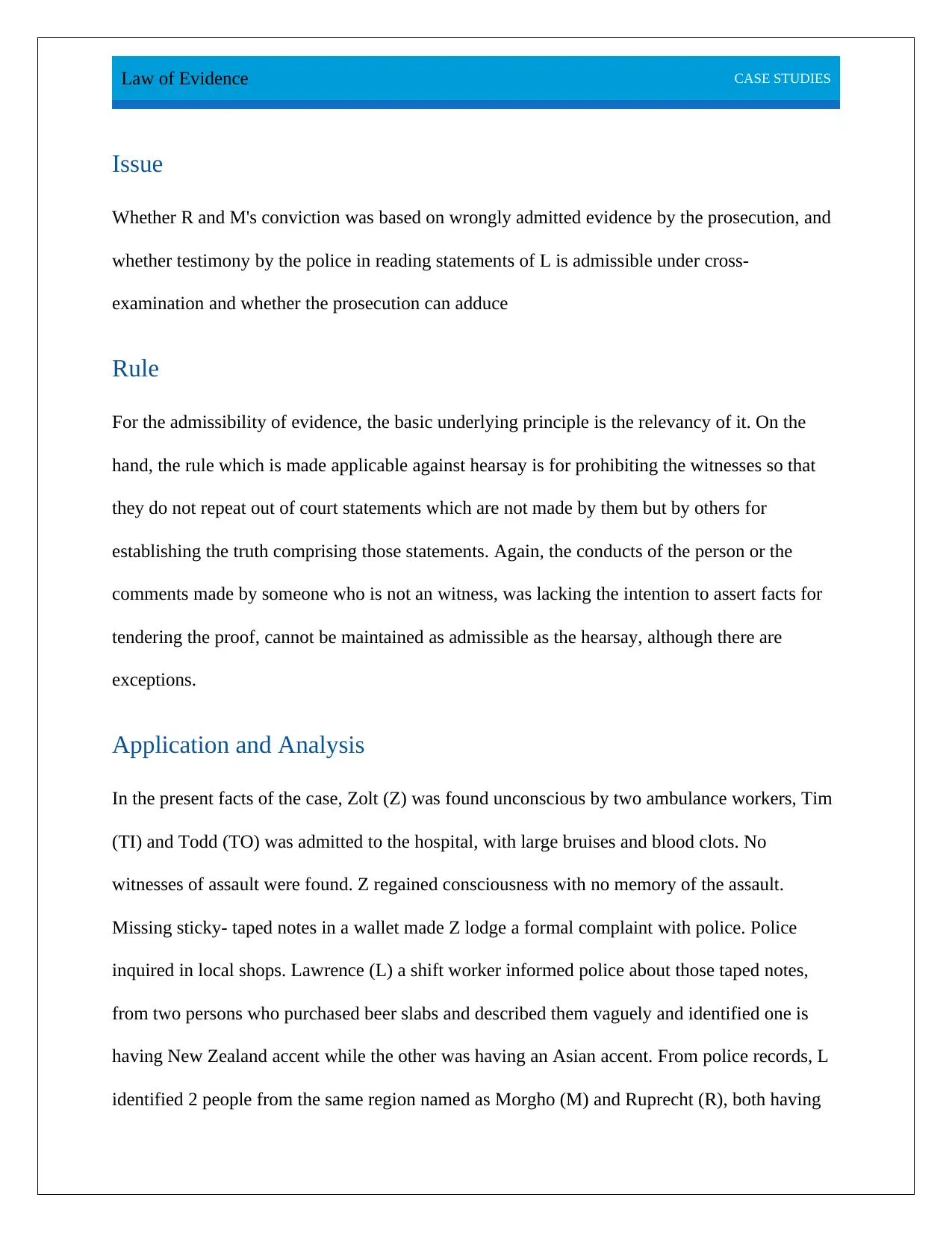
Law of Evidence CASE STUDIES
Issue
Whether R and M's conviction was based on wrongly admitted evidence by the prosecution, and
whether testimony by the police in reading statements of L is admissible under cross-
examination and whether the prosecution can adduce
Rule
For the admissibility of evidence, the basic underlying principle is the relevancy of it. On the
hand, the rule which is made applicable against hearsay is for prohibiting the witnesses so that
they do not repeat out of court statements which are not made by them but by others for
establishing the truth comprising those statements. Again, the conducts of the person or the
comments made by someone who is not an witness, was lacking the intention to assert facts for
tendering the proof, cannot be maintained as admissible as the hearsay, although there are
exceptions.
Application and Analysis
In the present facts of the case, Zolt (Z) was found unconscious by two ambulance workers, Tim
(TI) and Todd (TO) was admitted to the hospital, with large bruises and blood clots. No
witnesses of assault were found. Z regained consciousness with no memory of the assault.
Missing sticky- taped notes in a wallet made Z lodge a formal complaint with police. Police
inquired in local shops. Lawrence (L) a shift worker informed police about those taped notes,
from two persons who purchased beer slabs and described them vaguely and identified one is
having New Zealand accent while the other was having an Asian accent. From police records, L
identified 2 people from the same region named as Morgho (M) and Ruprecht (R), both having
Issue
Whether R and M's conviction was based on wrongly admitted evidence by the prosecution, and
whether testimony by the police in reading statements of L is admissible under cross-
examination and whether the prosecution can adduce
Rule
For the admissibility of evidence, the basic underlying principle is the relevancy of it. On the
hand, the rule which is made applicable against hearsay is for prohibiting the witnesses so that
they do not repeat out of court statements which are not made by them but by others for
establishing the truth comprising those statements. Again, the conducts of the person or the
comments made by someone who is not an witness, was lacking the intention to assert facts for
tendering the proof, cannot be maintained as admissible as the hearsay, although there are
exceptions.
Application and Analysis
In the present facts of the case, Zolt (Z) was found unconscious by two ambulance workers, Tim
(TI) and Todd (TO) was admitted to the hospital, with large bruises and blood clots. No
witnesses of assault were found. Z regained consciousness with no memory of the assault.
Missing sticky- taped notes in a wallet made Z lodge a formal complaint with police. Police
inquired in local shops. Lawrence (L) a shift worker informed police about those taped notes,
from two persons who purchased beer slabs and described them vaguely and identified one is
having New Zealand accent while the other was having an Asian accent. From police records, L
identified 2 people from the same region named as Morgho (M) and Ruprecht (R), both having
⊘ This is a preview!⊘
Do you want full access?
Subscribe today to unlock all pages.

Trusted by 1+ million students worldwide
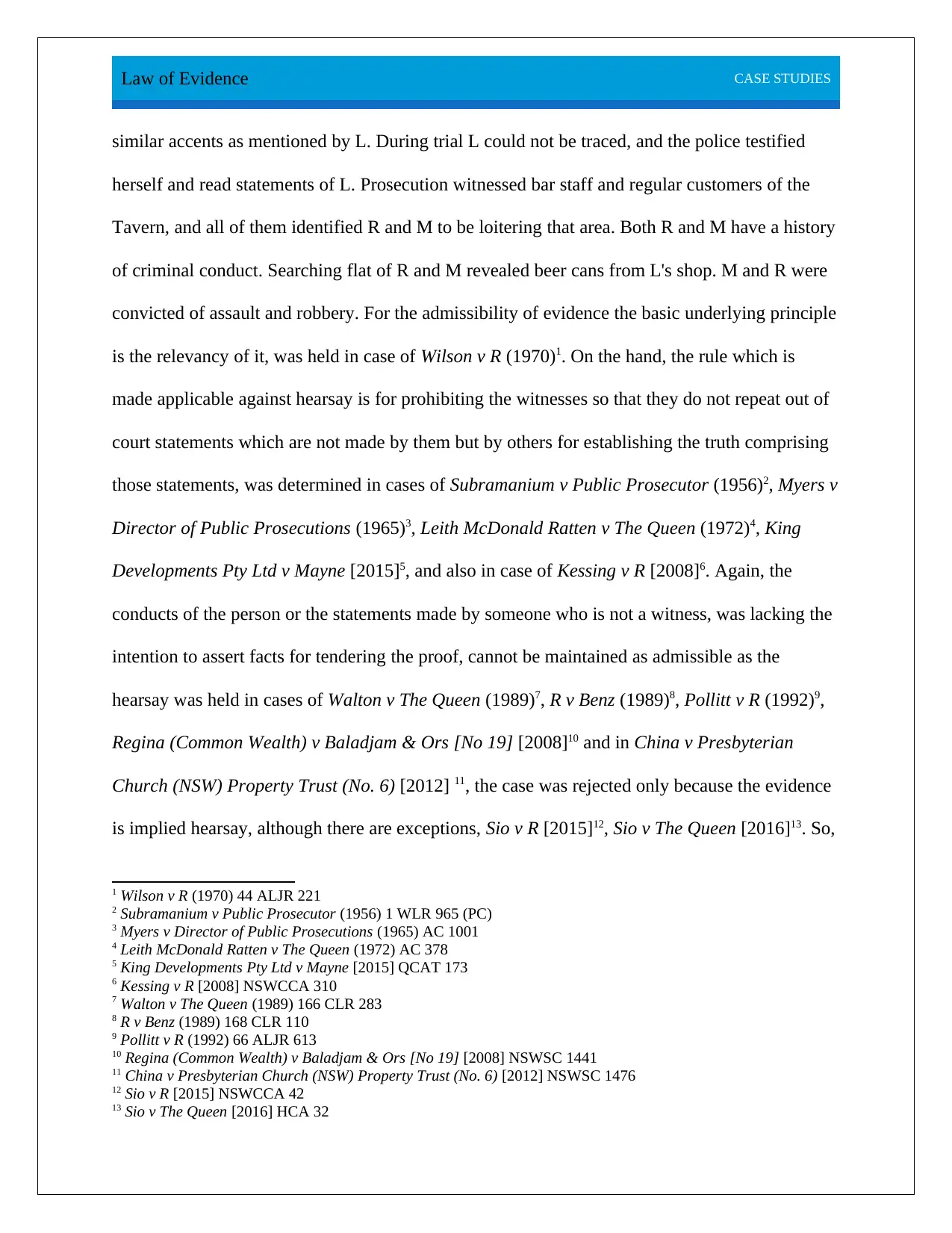
Law of Evidence CASE STUDIES
similar accents as mentioned by L. During trial L could not be traced, and the police testified
herself and read statements of L. Prosecution witnessed bar staff and regular customers of the
Tavern, and all of them identified R and M to be loitering that area. Both R and M have a history
of criminal conduct. Searching flat of R and M revealed beer cans from L's shop. M and R were
convicted of assault and robbery. For the admissibility of evidence the basic underlying principle
is the relevancy of it, was held in case of Wilson v R (1970)1. On the hand, the rule which is
made applicable against hearsay is for prohibiting the witnesses so that they do not repeat out of
court statements which are not made by them but by others for establishing the truth comprising
those statements, was determined in cases of Subramanium v Public Prosecutor (1956)2, Myers v
Director of Public Prosecutions (1965)3, Leith McDonald Ratten v The Queen (1972)4, King
Developments Pty Ltd v Mayne [2015]5, and also in case of Kessing v R [2008]6. Again, the
conducts of the person or the statements made by someone who is not a witness, was lacking the
intention to assert facts for tendering the proof, cannot be maintained as admissible as the
hearsay was held in cases of Walton v The Queen (1989)7, R v Benz (1989)8, Pollitt v R (1992)9,
Regina (Common Wealth) v Baladjam & Ors [No 19] [2008]10 and in China v Presbyterian
Church (NSW) Property Trust (No. 6) [2012] 11, the case was rejected only because the evidence
is implied hearsay, although there are exceptions, Sio v R [2015]12, Sio v The Queen [2016]13. So,
1 Wilson v R (1970) 44 ALJR 221
2 Subramanium v Public Prosecutor (1956) 1 WLR 965 (PC)
3 Myers v Director of Public Prosecutions (1965) AC 1001
4 Leith McDonald Ratten v The Queen (1972) AC 378
5 King Developments Pty Ltd v Mayne [2015] QCAT 173
6 Kessing v R [2008] NSWCCA 310
7 Walton v The Queen (1989) 166 CLR 283
8 R v Benz (1989) 168 CLR 110
9 Pollitt v R (1992) 66 ALJR 613
10 Regina (Common Wealth) v Baladjam & Ors [No 19] [2008] NSWSC 1441
11 China v Presbyterian Church (NSW) Property Trust (No. 6) [2012] NSWSC 1476
12 Sio v R [2015] NSWCCA 42
13 Sio v The Queen [2016] HCA 32
similar accents as mentioned by L. During trial L could not be traced, and the police testified
herself and read statements of L. Prosecution witnessed bar staff and regular customers of the
Tavern, and all of them identified R and M to be loitering that area. Both R and M have a history
of criminal conduct. Searching flat of R and M revealed beer cans from L's shop. M and R were
convicted of assault and robbery. For the admissibility of evidence the basic underlying principle
is the relevancy of it, was held in case of Wilson v R (1970)1. On the hand, the rule which is
made applicable against hearsay is for prohibiting the witnesses so that they do not repeat out of
court statements which are not made by them but by others for establishing the truth comprising
those statements, was determined in cases of Subramanium v Public Prosecutor (1956)2, Myers v
Director of Public Prosecutions (1965)3, Leith McDonald Ratten v The Queen (1972)4, King
Developments Pty Ltd v Mayne [2015]5, and also in case of Kessing v R [2008]6. Again, the
conducts of the person or the statements made by someone who is not a witness, was lacking the
intention to assert facts for tendering the proof, cannot be maintained as admissible as the
hearsay was held in cases of Walton v The Queen (1989)7, R v Benz (1989)8, Pollitt v R (1992)9,
Regina (Common Wealth) v Baladjam & Ors [No 19] [2008]10 and in China v Presbyterian
Church (NSW) Property Trust (No. 6) [2012] 11, the case was rejected only because the evidence
is implied hearsay, although there are exceptions, Sio v R [2015]12, Sio v The Queen [2016]13. So,
1 Wilson v R (1970) 44 ALJR 221
2 Subramanium v Public Prosecutor (1956) 1 WLR 965 (PC)
3 Myers v Director of Public Prosecutions (1965) AC 1001
4 Leith McDonald Ratten v The Queen (1972) AC 378
5 King Developments Pty Ltd v Mayne [2015] QCAT 173
6 Kessing v R [2008] NSWCCA 310
7 Walton v The Queen (1989) 166 CLR 283
8 R v Benz (1989) 168 CLR 110
9 Pollitt v R (1992) 66 ALJR 613
10 Regina (Common Wealth) v Baladjam & Ors [No 19] [2008] NSWSC 1441
11 China v Presbyterian Church (NSW) Property Trust (No. 6) [2012] NSWSC 1476
12 Sio v R [2015] NSWCCA 42
13 Sio v The Queen [2016] HCA 32
Paraphrase This Document
Need a fresh take? Get an instant paraphrase of this document with our AI Paraphraser
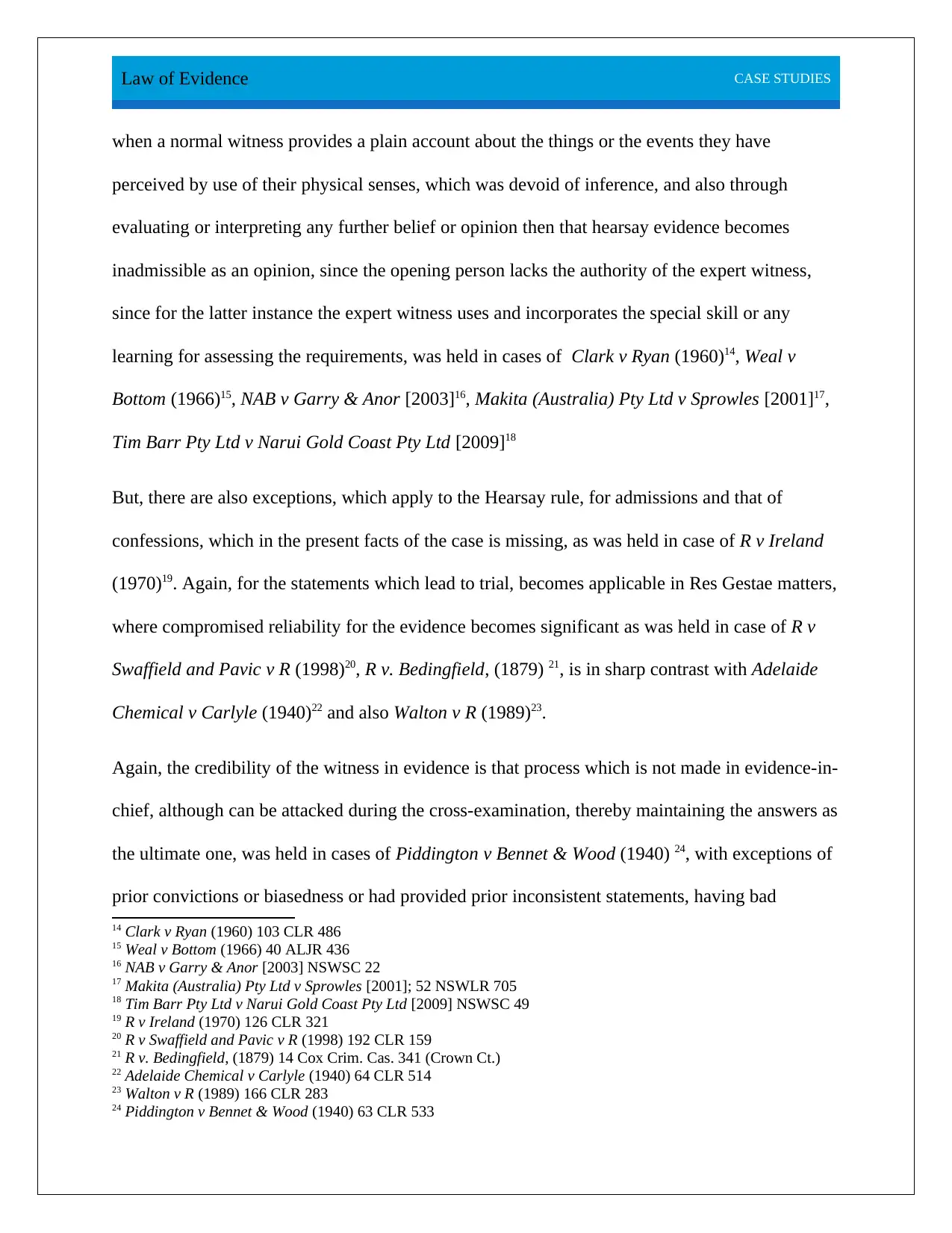
Law of Evidence CASE STUDIES
when a normal witness provides a plain account about the things or the events they have
perceived by use of their physical senses, which was devoid of inference, and also through
evaluating or interpreting any further belief or opinion then that hearsay evidence becomes
inadmissible as an opinion, since the opening person lacks the authority of the expert witness,
since for the latter instance the expert witness uses and incorporates the special skill or any
learning for assessing the requirements, was held in cases of Clark v Ryan (1960)14, Weal v
Bottom (1966)15, NAB v Garry & Anor [2003]16, Makita (Australia) Pty Ltd v Sprowles [2001]17,
Tim Barr Pty Ltd v Narui Gold Coast Pty Ltd [2009]18
But, there are also exceptions, which apply to the Hearsay rule, for admissions and that of
confessions, which in the present facts of the case is missing, as was held in case of R v Ireland
(1970)19. Again, for the statements which lead to trial, becomes applicable in Res Gestae matters,
where compromised reliability for the evidence becomes significant as was held in case of R v
Swaffield and Pavic v R (1998)20, R v. Bedingfield, (1879) 21, is in sharp contrast with Adelaide
Chemical v Carlyle (1940)22 and also Walton v R (1989)23.
Again, the credibility of the witness in evidence is that process which is not made in evidence-in-
chief, although can be attacked during the cross-examination, thereby maintaining the answers as
the ultimate one, was held in cases of Piddington v Bennet & Wood (1940) 24, with exceptions of
prior convictions or biasedness or had provided prior inconsistent statements, having bad
14 Clark v Ryan (1960) 103 CLR 486
15 Weal v Bottom (1966) 40 ALJR 436
16 NAB v Garry & Anor [2003] NSWSC 22
17 Makita (Australia) Pty Ltd v Sprowles [2001]; 52 NSWLR 705
18 Tim Barr Pty Ltd v Narui Gold Coast Pty Ltd [2009] NSWSC 49
19 R v Ireland (1970) 126 CLR 321
20 R v Swaffield and Pavic v R (1998) 192 CLR 159
21 R v. Bedingfield, (1879) 14 Cox Crim. Cas. 341 (Crown Ct.)
22 Adelaide Chemical v Carlyle (1940) 64 CLR 514
23 Walton v R (1989) 166 CLR 283
24 Piddington v Bennet & Wood (1940) 63 CLR 533
when a normal witness provides a plain account about the things or the events they have
perceived by use of their physical senses, which was devoid of inference, and also through
evaluating or interpreting any further belief or opinion then that hearsay evidence becomes
inadmissible as an opinion, since the opening person lacks the authority of the expert witness,
since for the latter instance the expert witness uses and incorporates the special skill or any
learning for assessing the requirements, was held in cases of Clark v Ryan (1960)14, Weal v
Bottom (1966)15, NAB v Garry & Anor [2003]16, Makita (Australia) Pty Ltd v Sprowles [2001]17,
Tim Barr Pty Ltd v Narui Gold Coast Pty Ltd [2009]18
But, there are also exceptions, which apply to the Hearsay rule, for admissions and that of
confessions, which in the present facts of the case is missing, as was held in case of R v Ireland
(1970)19. Again, for the statements which lead to trial, becomes applicable in Res Gestae matters,
where compromised reliability for the evidence becomes significant as was held in case of R v
Swaffield and Pavic v R (1998)20, R v. Bedingfield, (1879) 21, is in sharp contrast with Adelaide
Chemical v Carlyle (1940)22 and also Walton v R (1989)23.
Again, the credibility of the witness in evidence is that process which is not made in evidence-in-
chief, although can be attacked during the cross-examination, thereby maintaining the answers as
the ultimate one, was held in cases of Piddington v Bennet & Wood (1940) 24, with exceptions of
prior convictions or biasedness or had provided prior inconsistent statements, having bad
14 Clark v Ryan (1960) 103 CLR 486
15 Weal v Bottom (1966) 40 ALJR 436
16 NAB v Garry & Anor [2003] NSWSC 22
17 Makita (Australia) Pty Ltd v Sprowles [2001]; 52 NSWLR 705
18 Tim Barr Pty Ltd v Narui Gold Coast Pty Ltd [2009] NSWSC 49
19 R v Ireland (1970) 126 CLR 321
20 R v Swaffield and Pavic v R (1998) 192 CLR 159
21 R v. Bedingfield, (1879) 14 Cox Crim. Cas. 341 (Crown Ct.)
22 Adelaide Chemical v Carlyle (1940) 64 CLR 514
23 Walton v R (1989) 166 CLR 283
24 Piddington v Bennet & Wood (1940) 63 CLR 533
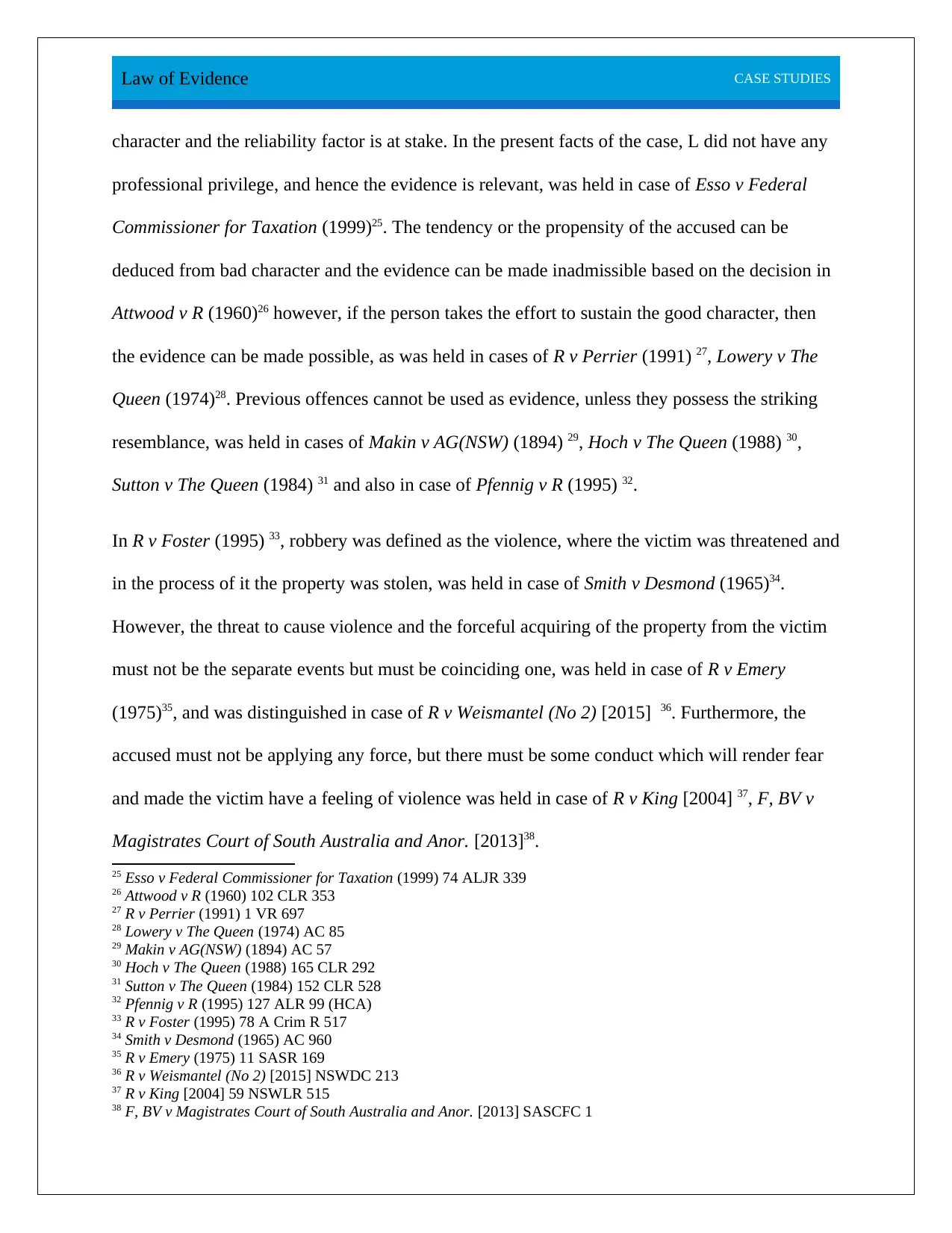
Law of Evidence CASE STUDIES
character and the reliability factor is at stake. In the present facts of the case, L did not have any
professional privilege, and hence the evidence is relevant, was held in case of Esso v Federal
Commissioner for Taxation (1999)25. The tendency or the propensity of the accused can be
deduced from bad character and the evidence can be made inadmissible based on the decision in
Attwood v R (1960)26 however, if the person takes the effort to sustain the good character, then
the evidence can be made possible, as was held in cases of R v Perrier (1991) 27, Lowery v The
Queen (1974)28. Previous offences cannot be used as evidence, unless they possess the striking
resemblance, was held in cases of Makin v AG(NSW) (1894) 29, Hoch v The Queen (1988) 30,
Sutton v The Queen (1984) 31 and also in case of Pfennig v R (1995) 32.
In R v Foster (1995) 33, robbery was defined as the violence, where the victim was threatened and
in the process of it the property was stolen, was held in case of Smith v Desmond (1965)34.
However, the threat to cause violence and the forceful acquiring of the property from the victim
must not be the separate events but must be coinciding one, was held in case of R v Emery
(1975)35, and was distinguished in case of R v Weismantel (No 2) [2015] 36. Furthermore, the
accused must not be applying any force, but there must be some conduct which will render fear
and made the victim have a feeling of violence was held in case of R v King [2004] 37, F, BV v
Magistrates Court of South Australia and Anor. [2013]38.
25 Esso v Federal Commissioner for Taxation (1999) 74 ALJR 339
26 Attwood v R (1960) 102 CLR 353
27 R v Perrier (1991) 1 VR 697
28 Lowery v The Queen (1974) AC 85
29 Makin v AG(NSW) (1894) AC 57
30 Hoch v The Queen (1988) 165 CLR 292
31 Sutton v The Queen (1984) 152 CLR 528
32 Pfennig v R (1995) 127 ALR 99 (HCA)
33 R v Foster (1995) 78 A Crim R 517
34 Smith v Desmond (1965) AC 960
35 R v Emery (1975) 11 SASR 169
36 R v Weismantel (No 2) [2015] NSWDC 213
37 R v King [2004] 59 NSWLR 515
38 F, BV v Magistrates Court of South Australia and Anor. [2013] SASCFC 1
character and the reliability factor is at stake. In the present facts of the case, L did not have any
professional privilege, and hence the evidence is relevant, was held in case of Esso v Federal
Commissioner for Taxation (1999)25. The tendency or the propensity of the accused can be
deduced from bad character and the evidence can be made inadmissible based on the decision in
Attwood v R (1960)26 however, if the person takes the effort to sustain the good character, then
the evidence can be made possible, as was held in cases of R v Perrier (1991) 27, Lowery v The
Queen (1974)28. Previous offences cannot be used as evidence, unless they possess the striking
resemblance, was held in cases of Makin v AG(NSW) (1894) 29, Hoch v The Queen (1988) 30,
Sutton v The Queen (1984) 31 and also in case of Pfennig v R (1995) 32.
In R v Foster (1995) 33, robbery was defined as the violence, where the victim was threatened and
in the process of it the property was stolen, was held in case of Smith v Desmond (1965)34.
However, the threat to cause violence and the forceful acquiring of the property from the victim
must not be the separate events but must be coinciding one, was held in case of R v Emery
(1975)35, and was distinguished in case of R v Weismantel (No 2) [2015] 36. Furthermore, the
accused must not be applying any force, but there must be some conduct which will render fear
and made the victim have a feeling of violence was held in case of R v King [2004] 37, F, BV v
Magistrates Court of South Australia and Anor. [2013]38.
25 Esso v Federal Commissioner for Taxation (1999) 74 ALJR 339
26 Attwood v R (1960) 102 CLR 353
27 R v Perrier (1991) 1 VR 697
28 Lowery v The Queen (1974) AC 85
29 Makin v AG(NSW) (1894) AC 57
30 Hoch v The Queen (1988) 165 CLR 292
31 Sutton v The Queen (1984) 152 CLR 528
32 Pfennig v R (1995) 127 ALR 99 (HCA)
33 R v Foster (1995) 78 A Crim R 517
34 Smith v Desmond (1965) AC 960
35 R v Emery (1975) 11 SASR 169
36 R v Weismantel (No 2) [2015] NSWDC 213
37 R v King [2004] 59 NSWLR 515
38 F, BV v Magistrates Court of South Australia and Anor. [2013] SASCFC 1
⊘ This is a preview!⊘
Do you want full access?
Subscribe today to unlock all pages.

Trusted by 1+ million students worldwide
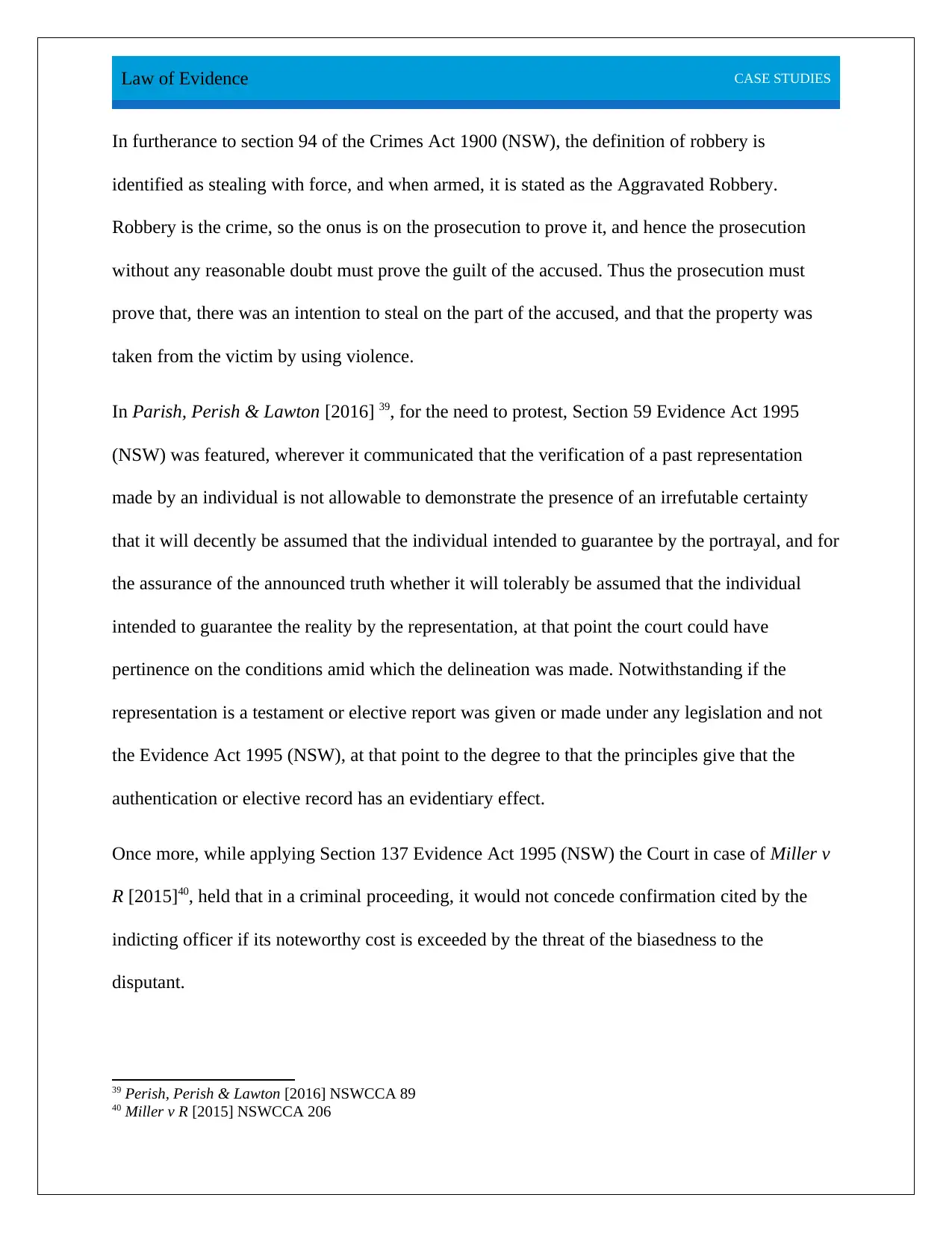
Law of Evidence CASE STUDIES
In furtherance to section 94 of the Crimes Act 1900 (NSW), the definition of robbery is
identified as stealing with force, and when armed, it is stated as the Aggravated Robbery.
Robbery is the crime, so the onus is on the prosecution to prove it, and hence the prosecution
without any reasonable doubt must prove the guilt of the accused. Thus the prosecution must
prove that, there was an intention to steal on the part of the accused, and that the property was
taken from the victim by using violence.
In Parish, Perish & Lawton [2016] 39, for the need to protest, Section 59 Evidence Act 1995
(NSW) was featured, wherever it communicated that the verification of a past representation
made by an individual is not allowable to demonstrate the presence of an irrefutable certainty
that it will decently be assumed that the individual intended to guarantee by the portrayal, and for
the assurance of the announced truth whether it will tolerably be assumed that the individual
intended to guarantee the reality by the representation, at that point the court could have
pertinence on the conditions amid which the delineation was made. Notwithstanding if the
representation is a testament or elective report was given or made under any legislation and not
the Evidence Act 1995 (NSW), at that point to the degree to that the principles give that the
authentication or elective record has an evidentiary effect.
Once more, while applying Section 137 Evidence Act 1995 (NSW) the Court in case of Miller v
R [2015]40, held that in a criminal proceeding, it would not concede confirmation cited by the
indicting officer if its noteworthy cost is exceeded by the threat of the biasedness to the
disputant.
39 Perish, Perish & Lawton [2016] NSWCCA 89
40 Miller v R [2015] NSWCCA 206
In furtherance to section 94 of the Crimes Act 1900 (NSW), the definition of robbery is
identified as stealing with force, and when armed, it is stated as the Aggravated Robbery.
Robbery is the crime, so the onus is on the prosecution to prove it, and hence the prosecution
without any reasonable doubt must prove the guilt of the accused. Thus the prosecution must
prove that, there was an intention to steal on the part of the accused, and that the property was
taken from the victim by using violence.
In Parish, Perish & Lawton [2016] 39, for the need to protest, Section 59 Evidence Act 1995
(NSW) was featured, wherever it communicated that the verification of a past representation
made by an individual is not allowable to demonstrate the presence of an irrefutable certainty
that it will decently be assumed that the individual intended to guarantee by the portrayal, and for
the assurance of the announced truth whether it will tolerably be assumed that the individual
intended to guarantee the reality by the representation, at that point the court could have
pertinence on the conditions amid which the delineation was made. Notwithstanding if the
representation is a testament or elective report was given or made under any legislation and not
the Evidence Act 1995 (NSW), at that point to the degree to that the principles give that the
authentication or elective record has an evidentiary effect.
Once more, while applying Section 137 Evidence Act 1995 (NSW) the Court in case of Miller v
R [2015]40, held that in a criminal proceeding, it would not concede confirmation cited by the
indicting officer if its noteworthy cost is exceeded by the threat of the biasedness to the
disputant.
39 Perish, Perish & Lawton [2016] NSWCCA 89
40 Miller v R [2015] NSWCCA 206
Paraphrase This Document
Need a fresh take? Get an instant paraphrase of this document with our AI Paraphraser
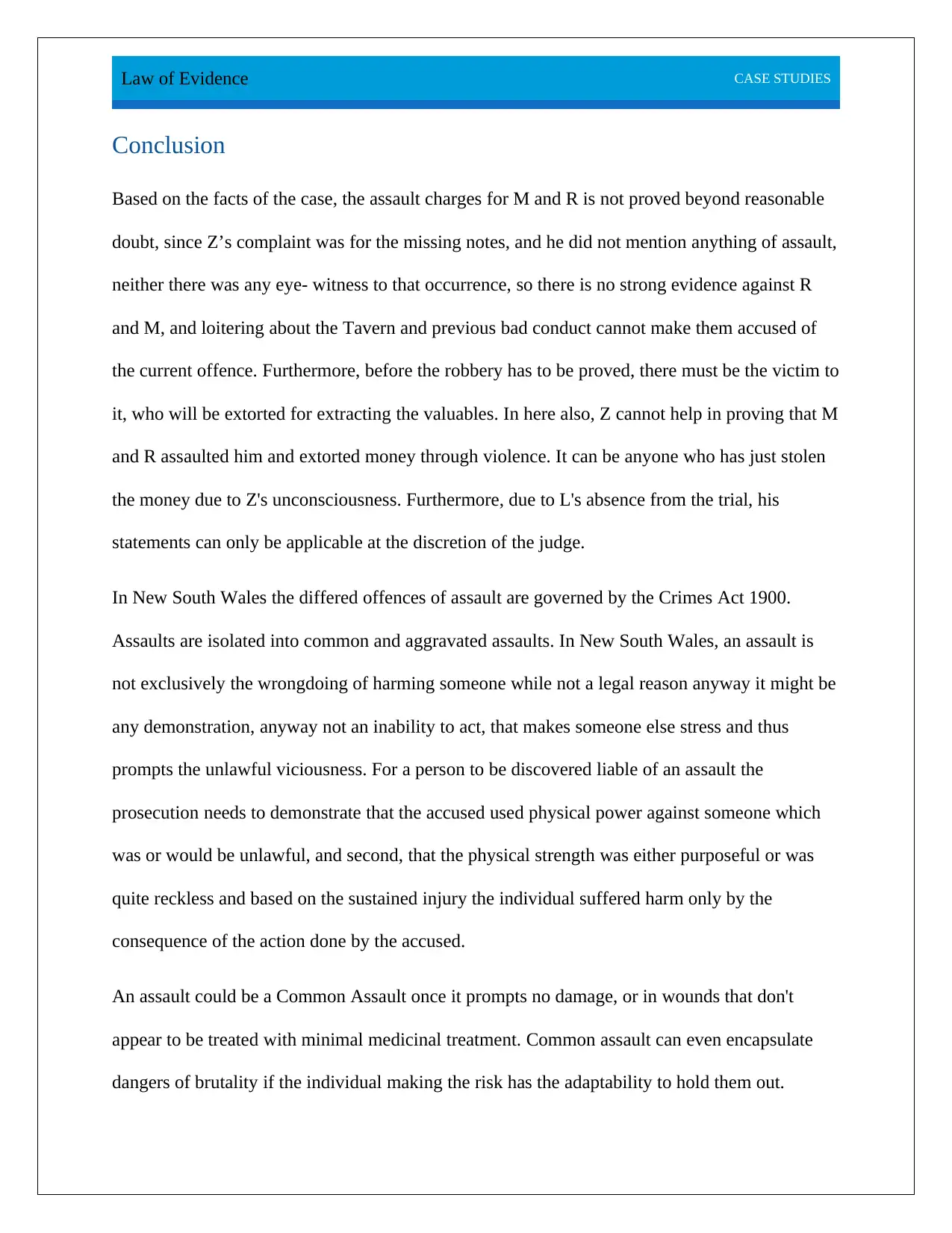
Law of Evidence CASE STUDIES
Conclusion
Based on the facts of the case, the assault charges for M and R is not proved beyond reasonable
doubt, since Z’s complaint was for the missing notes, and he did not mention anything of assault,
neither there was any eye- witness to that occurrence, so there is no strong evidence against R
and M, and loitering about the Tavern and previous bad conduct cannot make them accused of
the current offence. Furthermore, before the robbery has to be proved, there must be the victim to
it, who will be extorted for extracting the valuables. In here also, Z cannot help in proving that M
and R assaulted him and extorted money through violence. It can be anyone who has just stolen
the money due to Z's unconsciousness. Furthermore, due to L's absence from the trial, his
statements can only be applicable at the discretion of the judge.
In New South Wales the differed offences of assault are governed by the Crimes Act 1900.
Assaults are isolated into common and aggravated assaults. In New South Wales, an assault is
not exclusively the wrongdoing of harming someone while not a legal reason anyway it might be
any demonstration, anyway not an inability to act, that makes someone else stress and thus
prompts the unlawful viciousness. For a person to be discovered liable of an assault the
prosecution needs to demonstrate that the accused used physical power against someone which
was or would be unlawful, and second, that the physical strength was either purposeful or was
quite reckless and based on the sustained injury the individual suffered harm only by the
consequence of the action done by the accused.
An assault could be a Common Assault once it prompts no damage, or in wounds that don't
appear to be treated with minimal medicinal treatment. Common assault can even encapsulate
dangers of brutality if the individual making the risk has the adaptability to hold them out.
Conclusion
Based on the facts of the case, the assault charges for M and R is not proved beyond reasonable
doubt, since Z’s complaint was for the missing notes, and he did not mention anything of assault,
neither there was any eye- witness to that occurrence, so there is no strong evidence against R
and M, and loitering about the Tavern and previous bad conduct cannot make them accused of
the current offence. Furthermore, before the robbery has to be proved, there must be the victim to
it, who will be extorted for extracting the valuables. In here also, Z cannot help in proving that M
and R assaulted him and extorted money through violence. It can be anyone who has just stolen
the money due to Z's unconsciousness. Furthermore, due to L's absence from the trial, his
statements can only be applicable at the discretion of the judge.
In New South Wales the differed offences of assault are governed by the Crimes Act 1900.
Assaults are isolated into common and aggravated assaults. In New South Wales, an assault is
not exclusively the wrongdoing of harming someone while not a legal reason anyway it might be
any demonstration, anyway not an inability to act, that makes someone else stress and thus
prompts the unlawful viciousness. For a person to be discovered liable of an assault the
prosecution needs to demonstrate that the accused used physical power against someone which
was or would be unlawful, and second, that the physical strength was either purposeful or was
quite reckless and based on the sustained injury the individual suffered harm only by the
consequence of the action done by the accused.
An assault could be a Common Assault once it prompts no damage, or in wounds that don't
appear to be treated with minimal medicinal treatment. Common assault can even encapsulate
dangers of brutality if the individual making the risk has the adaptability to hold them out.
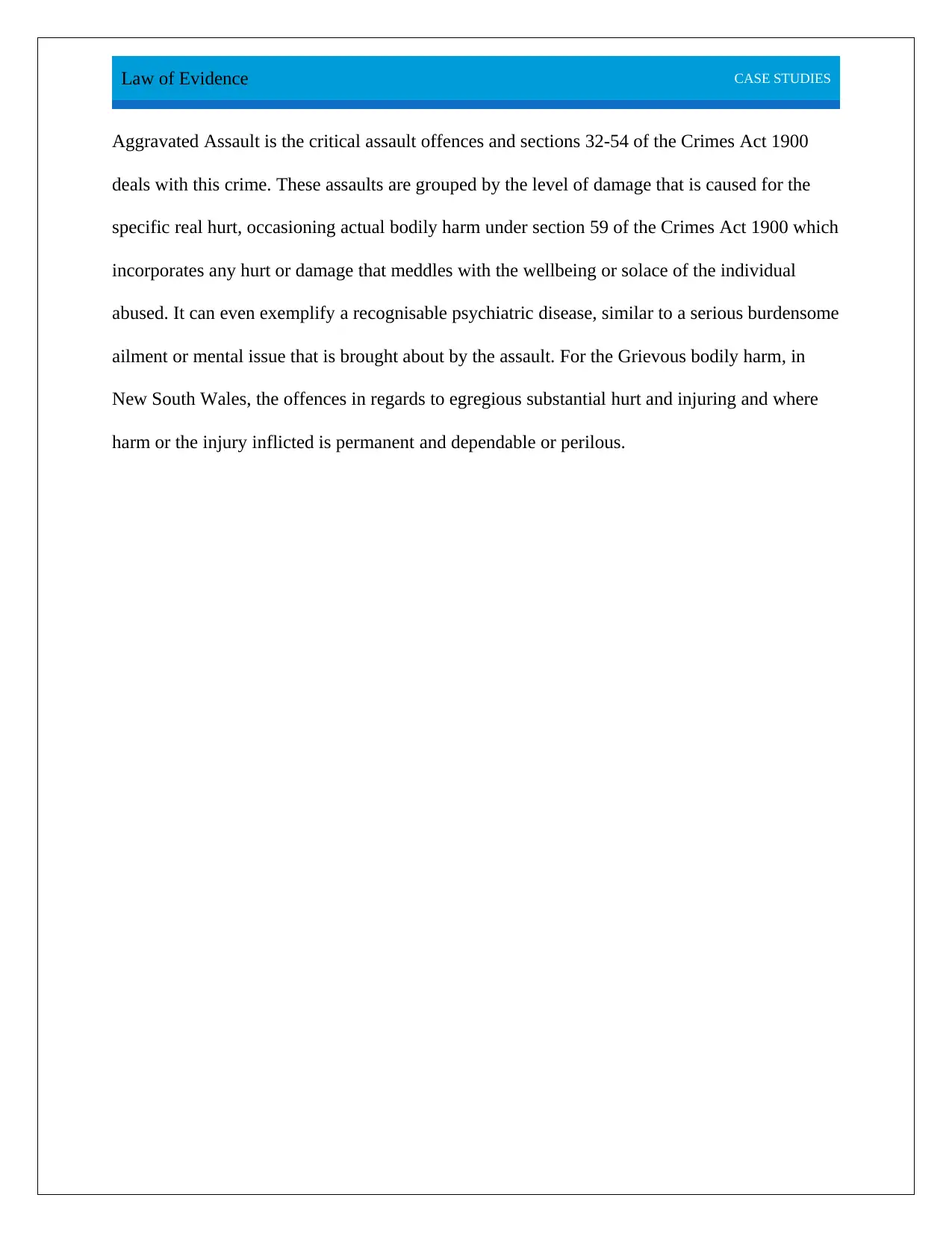
Law of Evidence CASE STUDIES
Aggravated Assault is the critical assault offences and sections 32-54 of the Crimes Act 1900
deals with this crime. These assaults are grouped by the level of damage that is caused for the
specific real hurt, occasioning actual bodily harm under section 59 of the Crimes Act 1900 which
incorporates any hurt or damage that meddles with the wellbeing or solace of the individual
abused. It can even exemplify a recognisable psychiatric disease, similar to a serious burdensome
ailment or mental issue that is brought about by the assault. For the Grievous bodily harm, in
New South Wales, the offences in regards to egregious substantial hurt and injuring and where
harm or the injury inflicted is permanent and dependable or perilous.
Aggravated Assault is the critical assault offences and sections 32-54 of the Crimes Act 1900
deals with this crime. These assaults are grouped by the level of damage that is caused for the
specific real hurt, occasioning actual bodily harm under section 59 of the Crimes Act 1900 which
incorporates any hurt or damage that meddles with the wellbeing or solace of the individual
abused. It can even exemplify a recognisable psychiatric disease, similar to a serious burdensome
ailment or mental issue that is brought about by the assault. For the Grievous bodily harm, in
New South Wales, the offences in regards to egregious substantial hurt and injuring and where
harm or the injury inflicted is permanent and dependable or perilous.
⊘ This is a preview!⊘
Do you want full access?
Subscribe today to unlock all pages.

Trusted by 1+ million students worldwide

Law of Evidence CASE STUDIES
BIBLIOGRAPHY
A Articles/ Books/ Reports
B Cases
Adelaide Chemical v Carlyle (1940) 64 CLR 514
Attwood v R (1960) 102 CLR 353)
Chaina v Presbyterian Church (NSW) Property Trust (No. 6) [2012] NSWSC 1476
Clark v Ryan (1960) 103 CLR 486
Esso v Federal Commissioner for Taxation (1999) 74 ALJR 339
F, BV v Magistrates Court of South Australia and Anor. [2013] SASCFC 1.
Hoch v The Queen (1988) 165 CLR 292
Kessing v R [2008] NSWCCA 310
King Developments Pty Ltd v Mayne [2015] QCAT 173
Leith McDonald Ratten v The Queen (1972) AC 378
Lowery v The Queen (1974) AC 85
Makin v AG(NSW) (1894) AC 57
Makita (Australia) Pty Ltd v Sprowles [2001] NSWCA 305; 52 NSWLR 705
Miller v R [2015] NSWCCA 206
Myers v Director of Public Prosecutions (1965) AC 1001
NAB v Garry & anor [2003] NSWSC 22
Perish, Perish & Lawton [2016] NSWCCA 89
Pfennig v R (1995) 127 ALR 99 (HCA).
Piddington v Bennet & Wood (1940) 63 CLR 533
R v Benz (1989) 168 CLR 110, Pollitt v R (1992) 66 ALJR 613
R v Emery (1975) 11 SASR 169
R v Foster (1995) 78 A Crim R 517 at 522
R v Ireland (1970) 126 CLR 321
R v King [2004] 59 NSWLR 515,
BIBLIOGRAPHY
A Articles/ Books/ Reports
B Cases
Adelaide Chemical v Carlyle (1940) 64 CLR 514
Attwood v R (1960) 102 CLR 353)
Chaina v Presbyterian Church (NSW) Property Trust (No. 6) [2012] NSWSC 1476
Clark v Ryan (1960) 103 CLR 486
Esso v Federal Commissioner for Taxation (1999) 74 ALJR 339
F, BV v Magistrates Court of South Australia and Anor. [2013] SASCFC 1.
Hoch v The Queen (1988) 165 CLR 292
Kessing v R [2008] NSWCCA 310
King Developments Pty Ltd v Mayne [2015] QCAT 173
Leith McDonald Ratten v The Queen (1972) AC 378
Lowery v The Queen (1974) AC 85
Makin v AG(NSW) (1894) AC 57
Makita (Australia) Pty Ltd v Sprowles [2001] NSWCA 305; 52 NSWLR 705
Miller v R [2015] NSWCCA 206
Myers v Director of Public Prosecutions (1965) AC 1001
NAB v Garry & anor [2003] NSWSC 22
Perish, Perish & Lawton [2016] NSWCCA 89
Pfennig v R (1995) 127 ALR 99 (HCA).
Piddington v Bennet & Wood (1940) 63 CLR 533
R v Benz (1989) 168 CLR 110, Pollitt v R (1992) 66 ALJR 613
R v Emery (1975) 11 SASR 169
R v Foster (1995) 78 A Crim R 517 at 522
R v Ireland (1970) 126 CLR 321
R v King [2004] 59 NSWLR 515,
Paraphrase This Document
Need a fresh take? Get an instant paraphrase of this document with our AI Paraphraser
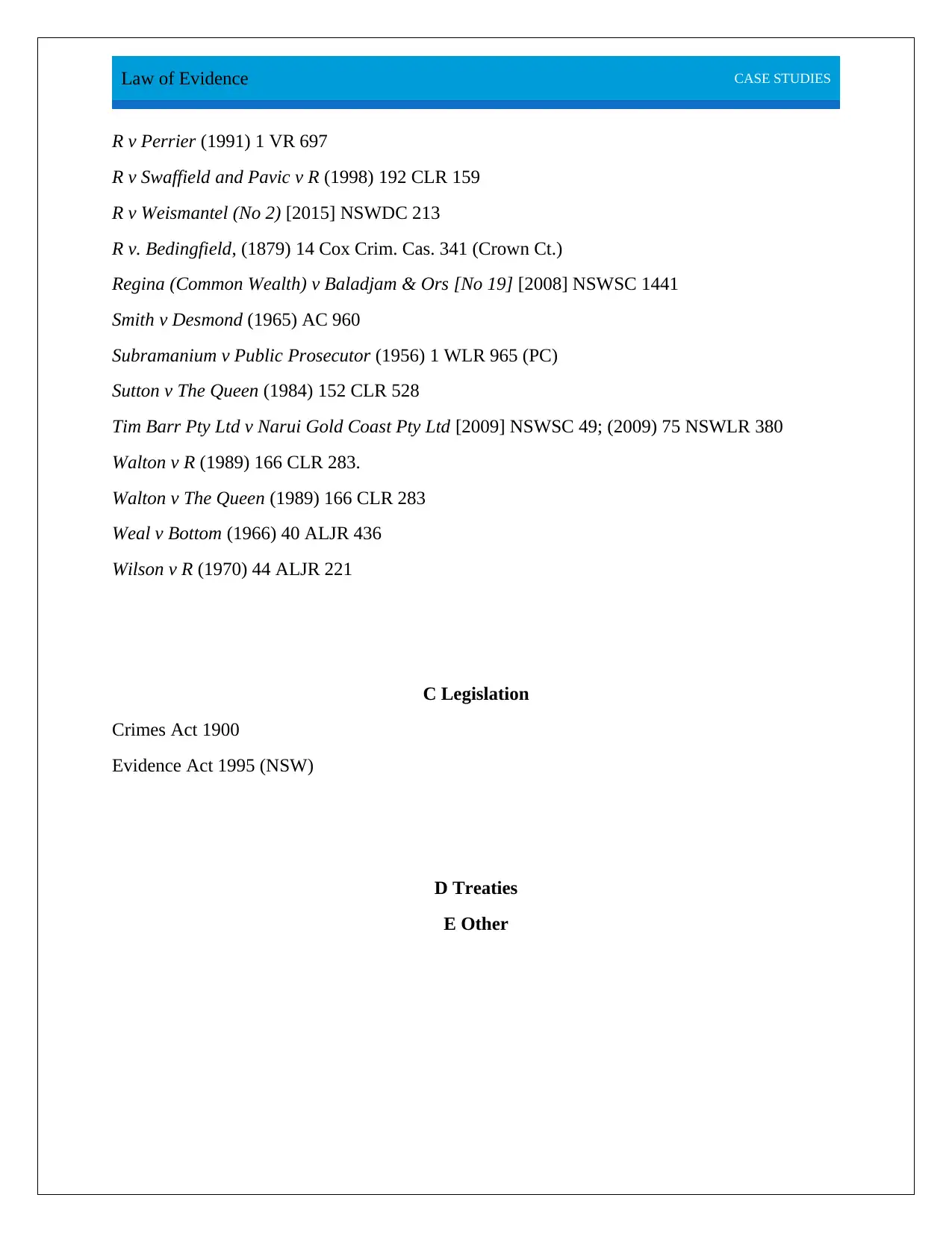
Law of Evidence CASE STUDIES
R v Perrier (1991) 1 VR 697
R v Swaffield and Pavic v R (1998) 192 CLR 159
R v Weismantel (No 2) [2015] NSWDC 213
R v. Bedingfield, (1879) 14 Cox Crim. Cas. 341 (Crown Ct.)
Regina (Common Wealth) v Baladjam & Ors [No 19] [2008] NSWSC 1441
Smith v Desmond (1965) AC 960
Subramanium v Public Prosecutor (1956) 1 WLR 965 (PC)
Sutton v The Queen (1984) 152 CLR 528
Tim Barr Pty Ltd v Narui Gold Coast Pty Ltd [2009] NSWSC 49; (2009) 75 NSWLR 380
Walton v R (1989) 166 CLR 283.
Walton v The Queen (1989) 166 CLR 283
Weal v Bottom (1966) 40 ALJR 436
Wilson v R (1970) 44 ALJR 221
C Legislation
Crimes Act 1900
Evidence Act 1995 (NSW)
D Treaties
E Other
R v Perrier (1991) 1 VR 697
R v Swaffield and Pavic v R (1998) 192 CLR 159
R v Weismantel (No 2) [2015] NSWDC 213
R v. Bedingfield, (1879) 14 Cox Crim. Cas. 341 (Crown Ct.)
Regina (Common Wealth) v Baladjam & Ors [No 19] [2008] NSWSC 1441
Smith v Desmond (1965) AC 960
Subramanium v Public Prosecutor (1956) 1 WLR 965 (PC)
Sutton v The Queen (1984) 152 CLR 528
Tim Barr Pty Ltd v Narui Gold Coast Pty Ltd [2009] NSWSC 49; (2009) 75 NSWLR 380
Walton v R (1989) 166 CLR 283.
Walton v The Queen (1989) 166 CLR 283
Weal v Bottom (1966) 40 ALJR 436
Wilson v R (1970) 44 ALJR 221
C Legislation
Crimes Act 1900
Evidence Act 1995 (NSW)
D Treaties
E Other
1 out of 11
Related Documents
Your All-in-One AI-Powered Toolkit for Academic Success.
+13062052269
info@desklib.com
Available 24*7 on WhatsApp / Email
![[object Object]](/_next/static/media/star-bottom.7253800d.svg)
Unlock your academic potential
© 2024 | Zucol Services PVT LTD | All rights reserved.





